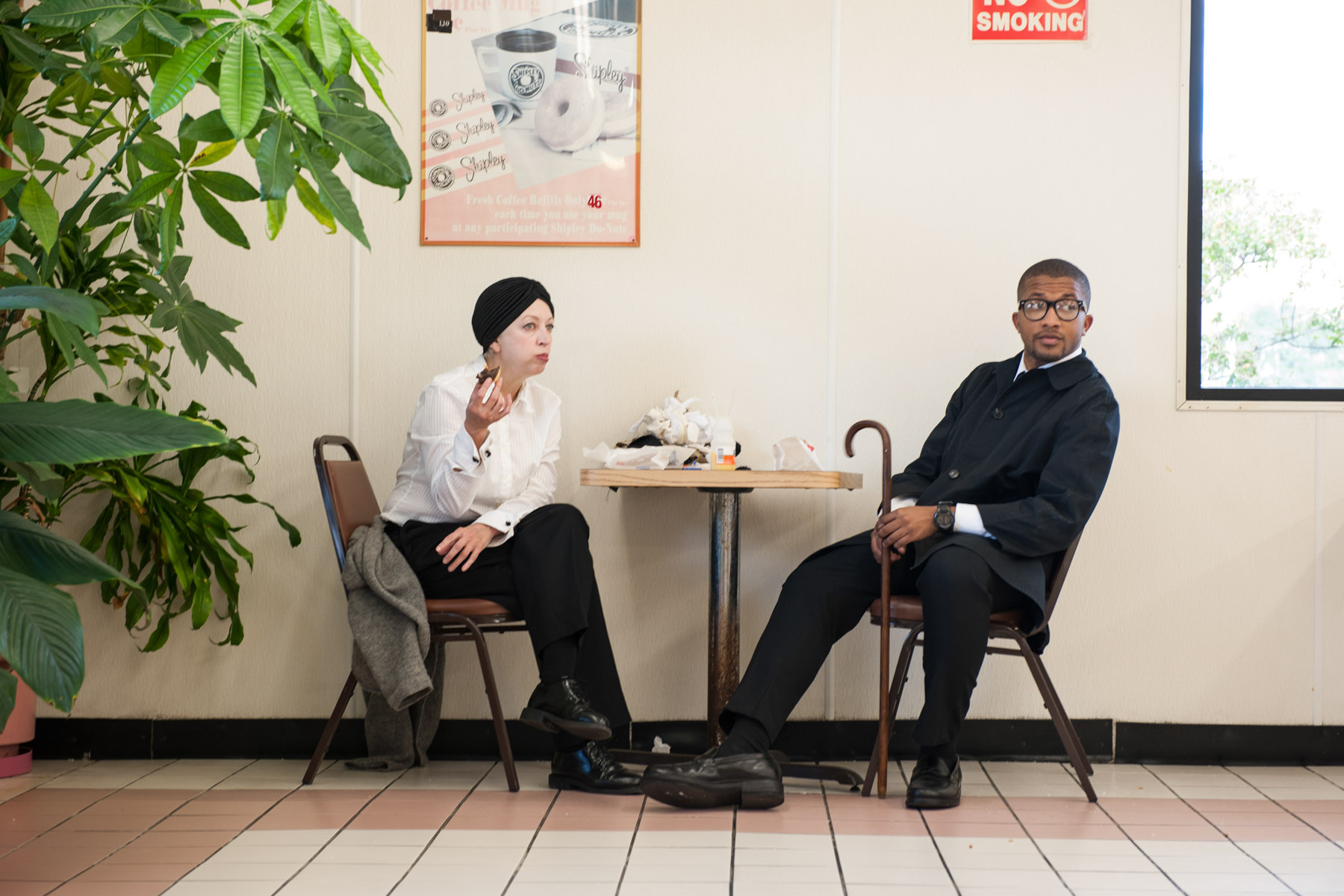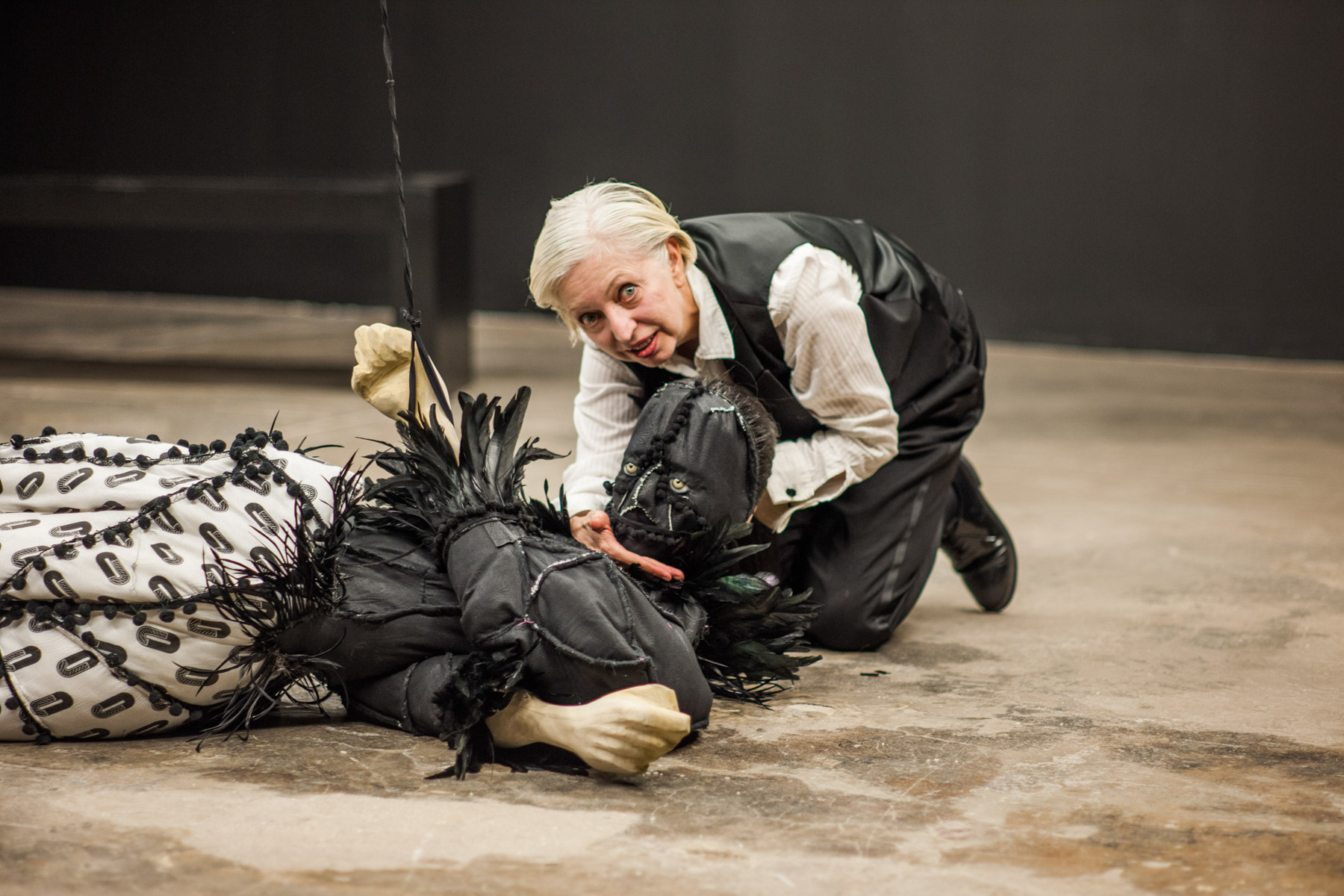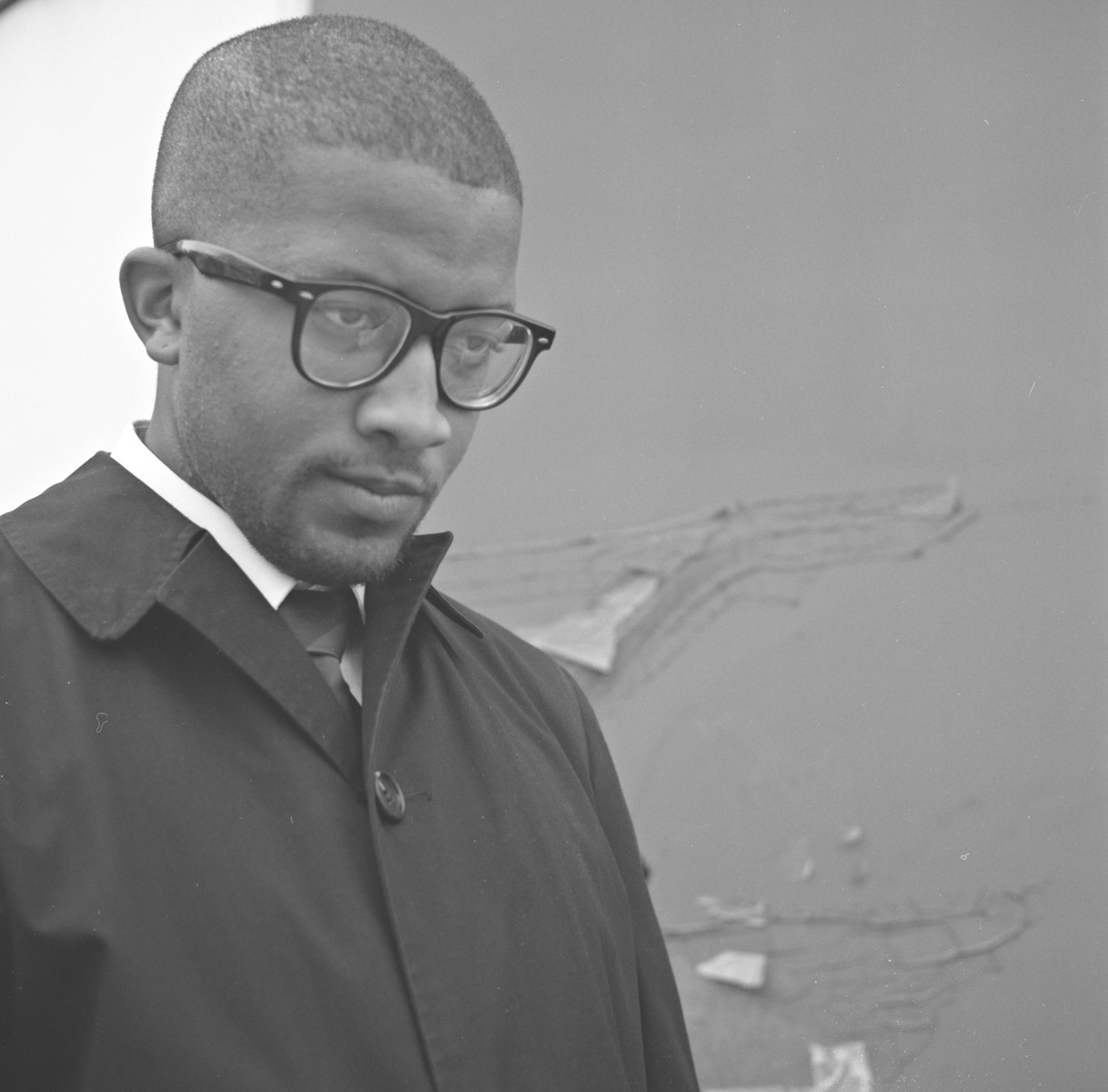2013, Houston, USA
Slyk Chaynjis
Play for two actors
Duration 6 hours
Commissioned by DiverseWorks














I don’t know when I am going to get out of this, either when she dies or I die. —Sancho
Slyk Chaynjis is an enigmatic tale about personal downfall and the subsequent reinvention of self, as told in six acts by a pair of unlikely traveling companions. Burdened by individual tragedies and personal failures, the characters—referred to as Slyk and Sancho—are inextricably bound by their respective roles in a common trauma and in a shared quest for personal redemption. Together, the outcast travelers are caught up in an epic journey to places unknown and for purposes unclear, staged within a fictional world of their own design—a delusional reality that conforms only to their peculiar sense of order and private moral code. Equal parts psychological drama, slapstick comedy, and absurdist theater, Slyk Chaynjis charts a poignant struggle to reconcile internal truths with public perceptions, suggesting that descending into madness may be an unconscious act of survival.
Slyk Chaynjis, the story’s title character and tragic heroine, and her sidekick serve as proxies for their creators. Like them, they have traveled a great distance to visit Houston, a foreign place in which they are outsiders with no allegiance to accepted conventions or opinions. While existing entirely within their own mythology, the artists and characters earnestly endeavor to make sense of the alien world that surrounds them and to reconcile it with their core beliefs and objectives. In the case of Slyk and Sancho, they seek to collapse internal and external realities by repeating their bizarre rituals every day and in the same order during their layover in Houston in the hopes of creating a more integrated existence. This endless repetition gives rise to an alternate universe built on the fusion of dualities—inside and outside, private and public, native and foreign, master and servant—and which inspires a more beautiful (or delusional) way of perceiving the world. Their Emerald City, however, is a fleeting one—soon they will depart in pursuit of that which forever eludes them, endlessly prolonging their Sisyphean existence and deepening their delusional enchantment.
I know she’s inside that building, I can see her in my dream,but I am outside, looking at the sealed door. —Sancho
Slyk’s psychological turmoil permeates the gallery space, a dark and dramatic refuge where fragmented clues to Slyk’s past surface through objects, actions, and soliloquies. Here, Slyk wrestles with her traumatic history as she rehearses the re-invented self she presents to the outside world—an odd music hall entertainer in the style of Charlie Chaplin’s Calvero. In accordance with the duality that underscores the entire play, Sancho counters Slyk in nearly every way—he remains outside the gallery at all times and opposes Slyk in appearance, demeanor, symbolism, and connection to reality. Inspired by the character of Don Quixote’s servant in Cervantes’ famous novel, he is Slyk’s trusted sidekick and fearless protector. Sancho shares Slyk’s strict adherence to an internal code of conduct, but follows his own eccentric set of rules in an effort to make amends for his past shortcomings. He consciously resides physically and psychically outside his master’s world, but the intensifying allure of her delusional enchantment becomes increasingly hard to resist. When Slyk exits the gallery and enters Sancho’s realm, the odd couple falls back into place and resumes their act in the streets of the city, like a modern day Laurel and Hardy off to change the world.
Slyk Chaynjis is an enigmatic tale about personal downfall and the subsequent reinvention of self, as told in six acts by a pair of unlikely traveling companions. Burdened by individual tragedies and personal failures, the characters—referred to as Slyk and Sancho—are inextricably bound by their respective roles in a common trauma and in a shared quest for personal redemption. Together, the outcast travelers are caught up in an epic journey to places unknown and for purposes unclear, staged within a fictional world of their own design—a delusional reality that conforms only to their peculiar sense of order and private moral code. Equal parts psychological drama, slapstick comedy, and absurdist theater, Slyk Chaynjis charts a poignant struggle to reconcile internal truths with public perceptions, suggesting that descending into madness may be an unconscious act of survival.
Slyk Chaynjis, the story’s title character and tragic heroine, and her sidekick serve as proxies for their creators. Like them, they have traveled a great distance to visit Houston, a foreign place in which they are outsiders with no allegiance to accepted conventions or opinions. While existing entirely within their own mythology, the artists and characters earnestly endeavor to make sense of the alien world that surrounds them and to reconcile it with their core beliefs and objectives. In the case of Slyk and Sancho, they seek to collapse internal and external realities by repeating their bizarre rituals every day and in the same order during their layover in Houston in the hopes of creating a more integrated existence. This endless repetition gives rise to an alternate universe built on the fusion of dualities—inside and outside, private and public, native and foreign, master and servant—and which inspires a more beautiful (or delusional) way of perceiving the world. Their Emerald City, however, is a fleeting one—soon they will depart in pursuit of that which forever eludes them, endlessly prolonging their Sisyphean existence and deepening their delusional enchantment.
I know she’s inside that building, I can see her in my dream,but I am outside, looking at the sealed door. —Sancho
Slyk’s psychological turmoil permeates the gallery space, a dark and dramatic refuge where fragmented clues to Slyk’s past surface through objects, actions, and soliloquies. Here, Slyk wrestles with her traumatic history as she rehearses the re-invented self she presents to the outside world—an odd music hall entertainer in the style of Charlie Chaplin’s Calvero. In accordance with the duality that underscores the entire play, Sancho counters Slyk in nearly every way—he remains outside the gallery at all times and opposes Slyk in appearance, demeanor, symbolism, and connection to reality. Inspired by the character of Don Quixote’s servant in Cervantes’ famous novel, he is Slyk’s trusted sidekick and fearless protector. Sancho shares Slyk’s strict adherence to an internal code of conduct, but follows his own eccentric set of rules in an effort to make amends for his past shortcomings. He consciously resides physically and psychically outside his master’s world, but the intensifying allure of her delusional enchantment becomes increasingly hard to resist. When Slyk exits the gallery and enters Sancho’s realm, the odd couple falls back into place and resumes their act in the streets of the city, like a modern day Laurel and Hardy off to change the world.
Heather and Ivan Morison strive to make art of the world. Their hard-to-define works, which take multiple forms and are often presented in unusual contexts, slip and slide between the interior realm of art and the pedestrian world of everyday life. This transitory slippage purposefully implicates us, the viewers, who (consciously or not) partake in an existential game of definition and validation.
Inside the hallowed space of the gallery, the Morisons’ works seem to conform to our textbook understanding of what art is: discrete objects on display for our visual and intellectual consumption. We walk around them, inspect them, perhaps admire them, and attempt to unlock their intrinsic meaning, at least as intended by the artist. The relationship between the artist and viewer—if there is one—exists solely within the transference of experiencing the object. In this conventional scenario, we, the viewers, are outsiders looking in. But when we let go—and this is what the Morisons excel at making us do—then we begin to notice how objects relate to one another, their context, and ourselves.
This connection between objects and the larger environment in which they are situated is of critical importance to the Morisons. In their installations, every detail is considered—the color of the walls, the placement of works, the specific type of lighting, the location of texts, as well as other elements, including the trajectory of physical bodies. How we, as viewers, might move through the space and interact with the works has also been contemplated by the artists who, by necessity, are open to multiple experiential possibilities. To those ends, the artists have had to relinquish absolute control and accept that we are part of the work and critical to its existence and meaning.
But what happens when someone other than us—a performer, perhaps—activates these pieces within the space? Do these individual works of art transform into simple props for telling a story? Are they still worthy of our study and desire? Does this change our initial impression of what they are, what they mean, and what their intrinsic value is? Now that they are part of a larger universe (but weren’t they always?) they seem to operate differently. We certainly understand them differently than we did when they were static. And, to further problematize this situation, what happens when the performer and prop leave the gallery and enter the city, into the real world? Does the object transform yet again? Is it still art? Or, by virtue of the audience that encounters it outside of the privileged sanctuary of the gallery, does it just become part of life? Then it is truly art of the world.
All’s well that ends — Slyk Chaynjis
Elizabeth Dunbar, Executive Director, DiverseWorks, Houston
Inside the hallowed space of the gallery, the Morisons’ works seem to conform to our textbook understanding of what art is: discrete objects on display for our visual and intellectual consumption. We walk around them, inspect them, perhaps admire them, and attempt to unlock their intrinsic meaning, at least as intended by the artist. The relationship between the artist and viewer—if there is one—exists solely within the transference of experiencing the object. In this conventional scenario, we, the viewers, are outsiders looking in. But when we let go—and this is what the Morisons excel at making us do—then we begin to notice how objects relate to one another, their context, and ourselves.
This connection between objects and the larger environment in which they are situated is of critical importance to the Morisons. In their installations, every detail is considered—the color of the walls, the placement of works, the specific type of lighting, the location of texts, as well as other elements, including the trajectory of physical bodies. How we, as viewers, might move through the space and interact with the works has also been contemplated by the artists who, by necessity, are open to multiple experiential possibilities. To those ends, the artists have had to relinquish absolute control and accept that we are part of the work and critical to its existence and meaning.
But what happens when someone other than us—a performer, perhaps—activates these pieces within the space? Do these individual works of art transform into simple props for telling a story? Are they still worthy of our study and desire? Does this change our initial impression of what they are, what they mean, and what their intrinsic value is? Now that they are part of a larger universe (but weren’t they always?) they seem to operate differently. We certainly understand them differently than we did when they were static. And, to further problematize this situation, what happens when the performer and prop leave the gallery and enter the city, into the real world? Does the object transform yet again? Is it still art? Or, by virtue of the audience that encounters it outside of the privileged sanctuary of the gallery, does it just become part of life? Then it is truly art of the world.
All’s well that ends — Slyk Chaynjis
Elizabeth Dunbar, Executive Director, DiverseWorks, Houston
Photographers’ credits
All images_ Ivan Morison
All images_ Ivan Morison